Avro Canada CF-100 Canuck Video - From "In Search Of"
|
|
Avro Canada CF-100 Canuck
CF-100 Canuck
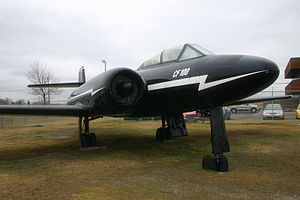
Picture - A CF-100 Mk 3 painted as the CF-100 prototype, on display at the Calgary AeroSpace Museum
Role: Interceptor
Manufacturer: Avro Canada
Designed by: John Frost
First flight: 19 January 1950
Introduced: 1952
Retired: 1981
Primary users: Royal Canadian Air Force
Belgian Air Force
Number built: 692
Variants: Avro Canada CF-103
The Avro Canada CF-100 Canuck (affectionately known as the "Clunk") was a Canadian jet interceptor/fighter serving during the Cold War both in NATO bases in Europe and as part of NORAD. The CF-100 was the only Canadian-designed fighter to enter mass production, serving primarily with the RCAF/CAF and in small numbers in Belgium. For its day, the CF-100 featured a short takeoff run and high climb rate, making it well suited to its role as an interceptor.
Design and development
In the early 1950s, Canada needed an all-weather interceptor (fighter) able to patrol the vast areas of Canada's north and operate in all weather conditions. The two-seat fighter crewed by a pilot and navigator, was designed with two powerful engines and an advanced radar and fire control system housed in its nose that enabled it to fly in all-weather or night conditions.
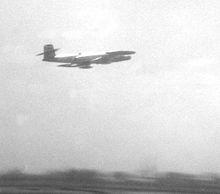
Picture - CF-100 Mk 4B in a "scramble" from RCAF St. Hubert, Quebec, c. 1962
Design of the XC-100 to meet a Royal Canadian Air Force (RCAF) specification for an all-weather fighter was initiated at Avro Canada in October 1946. Chief Engineer Edgar Atkin's work on the CF-100 was subsequently passed to John Frost formerly of de Havilland who, along with Avro's Chief Aerodynamacist Jim Chamberlin, reworked the original fuselage design. The CF-100 Mark 1 prototype, "18101," emerged out of the factory, painted gloss black overall with white lightning bolts running down the fuselage and engines. The CF-100 prototype flew its maiden flight on 19 January 1950 with Gloster Aircraft Company Chief Test Pilot S/L Bill Waterton at the controls. Waterton was on loan from the Gloster firm, another member of the Hawker Siddeley Group. The Mark 1 was powered by two Avon RA 3 turbojets with 28.9 kN (2,950 kgp / 6,500 lbf) thrust each.
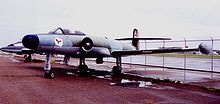
Picture - CF-100 MK 5D (18476) former CFB Namao and No. 414 Electronic Warfare (EW) Squadron #100476 painted as No. 440 Squadron RCAF Mk 4B serving in NATO and on display at the Alberta Aviation Museum.
The second prototype, 18102, was also powered by Rolls-Royce Avons, although subsequent pre-production and production series aircraft used the Avro Orenda turbojet. Five pre-production Mk 2 test aircraft were produced (18103-18107) all fitted with the Orenda 2 jet engines; one was fitted with dual controls and designated a Mk 2T trainer. The first production version, designated Mk 3, incorporated the APG-33 radar and was armed with eight 0.5 inch machine guns. The Mk 3CT and Mk 3DT were again dual control versions supplied to operational training units.
Production
In September 1950, the RCAF ordered 124 examples of the Mk 3 version; the first of these entering service in 1953. These were armed with eight .50-caliber machine guns. The definitive version rocket-armed Mk 4A was based on prototype Mk 4 (a modified Mk 3) first flying on 11 October 1952. The nose housed the much larger APG-40 radar with wingtip pods each containing up to 30 Mighty Mouse FFAR (folding fin aerial rockets) in addition to the guns. As the last 54 of an order for the Mk 3 were changed into the Mk 4 in 1954, total orders for the Mk.4 rose to 510. The Mk 4B version had more powerful Orenda 11s.
Five versions, or "marks", were produced, ending, from 1955 onwards, with the high-altitude Mk 5 that featured a 1.06m (3 ft. 6 in.) extended wingtip and enlarged tailplane, along with removal of the machine guns. The proposed Mk 6 was to have mounted Sparrow II missiles and been powered by afterburning Orenda 11IR engines in an effort to provide an "interim" fighter prior to the introduction of the Avro CF-105 Arrow. A projected transonic swept-wing CF-103 was built in mock-up form in 1951, but was considered obsolescent even before the CF-100's demonstrated ability to exceed the speed of sound in a dive. On 18 December 1952, S/L Janusz Żurakowski, the Avro company chief development test pilot, took the CF-100 Mk 4 prototype to Mach 1.0 in a dive from 30,000 ft. being the first straight-winged jet aircraft to achieve controlled supersonic flight.
Operational history
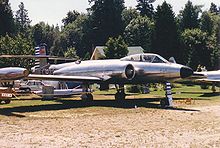
Picture - CF-100 Mk 3 at the Canadian Museum of Flight in July 1988
The Canuck was affectionately known in the RCAF as the "Clunk" because of the noise the front landing gear made as it retracted into its well after takeoff. Its less-attractive nickname was the "Lead Sled", a reference to its heavy controls and general lack of maneuverability, a nickname it shared with a number of other 1950s aircraft. Others included CF-Zero, the Zilch, the Beast, all references to an aircraft many pilots considered less glamourous than RCAF day fighters like the Canadair Sabre.
The aircraft operated under the US/Canadian North American Air Defense Command (NORAD) to protect North American airspace from Soviet intruders such as nuclear-armed bombers. Additionally, as part of the North Atlantic Treaty Organization (NATO), four Canuck squadrons were based in Europe with 1 Air Division from 1956-1962, and were for some time the only NATO fighters capable of operating in zero visibility and poor weather conditions.
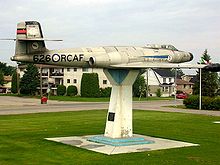
Picture - A CF-100 is on permanent display in North Bay's Lee Park
When the Korean War started, the USAF was in urgent need of a jet-propelled, all-weather, interdiction/surveillance aircraft. The urgency was so great that the USAF was willing to consider two foreign designs: the CF-100 and the English Electric Canberra. The CF-100 was rejected because of insufficient range and payload. The English Electric design was selected and developed into the B-57 Canberra.
The CF-100 served with nine RCAF squadrons at its peak in the mid-1950s. Four of these squadrons were deployed to Europe from late 1956-1962 under the NIMBLE BAT ferry program, replacing some NATO RCAF squadrons equipped with Canadair Sabre day fighters to provide all-weather defense against Soviet intruders. Canucks flying at home retained natural metal finish, but those flying overseas were given a British-style disruptive camouflage scheme - dark sea gray and green on top, light sea gray on the bottom.
During his Avro Canada years, the Chief Development Pilot, S/L Żurakowski, continued to fly as an aerobatic display pilot, with spectacular results, especially at the 1955 Farnborough Airshow where he displayed the CF-100 in a "falling-leaf." He was acclaimed again as the "Great Żura" by many aviation and industry observers who could not believe a large, all-weather fighter could be put through its paces so spectacularly. His performance led to Belgium purchasing the CF-100.
In its lifetime, 692 CF-100s of different variants were produced, including 53 aircraft delivered to the Belgian Air Force. Although originally designed for only 2,000 hours, it was found that the Canuck's airframe could serve for over 20,000 hours before retirement. Consequently, though it was replaced in its front line role by the CF-101 Voodoo, the Canuck served with 414 Squadron of the Canadian Forces at CFB North Bay, Ontario, until 1981, in reconnaissance, training and electronic warfare roles. After the CF-100 was retired, a number of aircraft still remain across Canada (and elsewhere) as static displays.
Its planned successor, the CF-105 Arrow along with the sophisticated Orenda Iroquois engine, both Canadian-designed, were cancelled in 1959 in a controversial decision by the Canadian government.
Variants
CF-100 Mk 1 : The first two prototypes.
CF-100 Mk 1P : Proposed photo-reconnaissance version. Not built.
CF-100 Mk 2 : Ten pre-production aircraft.
CF-100 Mk 2T : Two-seat training version of the CF-100 Mk 2. Two built.
CF-100 Mk 3 : Two-seat all-weather long-range interceptor fighter aircraft. First production version for the RCAF. 70 built.
CF-100 Mk 3A : CF-100 Mk 3 sub-type, powered by two Orenda 2 turbojet engines. 21 built.
CF-100 Mk 3B : CF-100 Mk 3 sub-type, powered by two Orenda 8 turbojet engines. 45 built.
CF-100 Mk 3CT : One CF-100 Mk 3 converted into a two-seat training aircraft. Later redesignated CF-100 Mk 3D.
CF-100 Mk 4 : Two-seat all-weather long-range interceptor fighter aircraft. One pre-production aircraft.
CF-100 Mk 4A : CF-100 Mk 4 sub-type, powered by two Orenda 9 turbojet engines. 137 built.
CF-100 Mk 4B : CF-100 Mk 4 sub-type, powered by two Orenda 11 turbojet engines. 141 built.
CF-100 Mk 4X : Proposed version of the CF-100 Mk 4. Not built.
CF-100 Mk 5 : Two-seat all-weather long-range interceptor fighter aircraft, powered by two Orenda 11 or Orenda 14 turbojet engines. 332 built.
CF-100 Mk 5D : Small number of CF-100 Mk 5s converted into ECM (Electronic Countermeasures), EW (Electronic Warfare) aircraft.
CF-100 Mk 5M : Small number of CF-100 Mk 5s equipped to carry the AIM-7 Sparrow II air-to-air missiles.
CF-100 Mk 6 : Proposed version armed with the AIM-7 Sparrow II air-to-air missile. Not built.
Operators
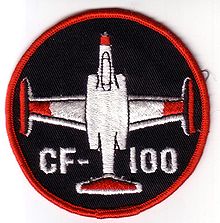
Picture - CF-100 badge worn by Canadian Forces crews in the 1970s and 80s
Belgium
Belgian Air Force (53 Mk 5s from 1957 to 1964)
11 Squadron
349 Squadron
350 Squadron
Canada
Royal Canadian Air Force
Canadian Forces
409 Squadron
410 Squadron
414 Squadron
416 Squadron
419 Squadron
423 Squadron
425 Squadron
428 Squadron
432 Squadron
433 Squadron
440 Squadron
445 Squadron
448 Squadron
Aircraft on display
Museums or sites which have an Avro Canada CF-100 on display:
4 Wing Cold Lake, Alberta
Alberta Aviation Museum, Edmonton, Alberta
Atlantic Canada Aviation Museum, Halifax, Nova Scotia
Base Borden Military Museum
Bomber Command Museum of Canada, Nanton, Alberta
Calgary Aerospace Museum
Canada Aviation Museum, Ottawa, Ontario
Canadian Museum of Flight, Langley, British Columbia
Canadian Warplane Heritage Museum
Centennial Park, Moncton, New Brunswick, Avro Canada CF-100 Canuck Mk 5 Serial Number 18488, 432 Squadron
CFB Winnipeg
Canadian Forces Garrison St. Hubert, Quebec
Comox Air Force Museum, Comox, BC
Head Lake Park, Haliburton, Ontario
Imperial War Museum Duxford, Duxford, Cambridgeshire, England, United Kingdom
John C. Munro Hamilton International Airport, Hamilton, Ontario
Memorial Military Museum, Campbellford, Ontario
National Air Force Museum of Canada, Trenton, Ontario
The National Museum of the United States Air Force, a Mk. 4A painted in 428 Sqn colours.
Nav Canada, Cornwall, Ontario
Reynolds-Alberta Museum, Wetaskiwin, Alberta
Royal Canadian Legion, Cornwall, Ontario
Royal Military College of Canada, Kingston, Ontario
Royal Military College Saint-Jean, Saint-Jean-sur-Richelieu, Quebec
Royal Museum of the Armed Forces and of Military History, Cinquantenaire, Brussels, Belgium
Wildwood Park, Malton, Ontario
Specifications (CF-100 Mk 5)
General characteristics
Crew: 2, pilot and navigator
Length: 16.5 m (54 ft 2 in)
Wingspan: 17.4 m (57 ft 2 in)
Height: 4.4 m (14 ft 6 in)
Wing area: 54.9 m² (591 ft²)
Empty weight: 10,500 kg (23,100 lb)
Loaded weight: 15,170 kg (33,450 lb)
Powerplant: 2x— Avro Canada Orenda 11 turbojets, 32.5 kN (7,300 lbf) each
Performance
Maximum speed: 888 km/h (552 mph)
Range: 3,200km (2,000mi)
Service ceiling: 13,700 m (45,000 ft)
Rate of climb: 44.5 m/s (8,750 ft/min)
Wing loading: kg/m² (lb/ft²)
Thrust/weight: 0.44
Armament
2 wingtip pods of 29 x 70-mm (2.75 in) "Mighty Mouse" fin-folding aerial rockets
Notable appearances in media
Aerospace Heritage Foundation of Canada
Orléans air disaster
Related development
Avro Canada CF-103
Comparable aircraft
Gloster Javelin
F-89 Scorpion
Bibliography
Baglow, Bob. Canucks Unlimited: Royal Canadian Air Force CF-100 Squadrons and Aircraft, 1952- 1963. Ottawa: Canuck Publishing, 1985. ISBN 0-9692246-0-5.
Lyzun, Jim. CF-100 Canuck. Ottawa: SMS Publishing, 1985. ISBN 0-920375-04-9.
Milberry, Larry. The Avro CF-100. Toronto: CANAV Books, 1981. ISBN 0-9690703-0-6.
Page, Ron. Canuck: CF-100 All Weather Fighter. Erin, Ontario: Boston Mills Press, 1981. ISBN 0-919822-39-8.
Whitcomb, Randall L. Cold War Tech War: The Politics of America's Air Defense. Burlington, Ontario: Apogee Books, 2008. ISBN 978-1-894959-77-3.
Avro Canada CF-100 Canuck Pictures and Avro Canada CF-100 Canuck for Sale.
Living Warbirds: The best warbirds DVD series.
Source: WikiPedia